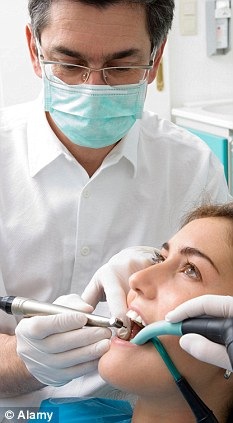By Pat Hagan
27th July 2010

A gel that can help decayed teeth grow back in just weeks may mean an end to fillings.
The gel, which is being developed by scientists in France, works by prompting cells in teeth to start multiplying. They then form healthy new tooth tissue that gradually replaces what has been lost to decay.
Researchers say in lab studies it took just four weeks to restore teeth back to their original healthy state. The gel contains melanocyte-stimulating hormone, or MSH.
We produce this in the pituitary gland, a pea-sized gland just behind the bridge of the nose.
MSH is already known to play an important part in determining skin colour - the more you have, the darker your flesh tone.
But recent studies suggest MSH may also play a crucial role in stimulating bone regeneration.
As bone and teeth are very similar in their structure, a team of scientists at the National Institute for Health and Medical Research in Paris tested if the hormone could stimulate tooth growth.
Their findings, published in the American Chemical Society journal ACS Nano, could signal hurtnot just an end to fillings, but the dreaded dentist drill as well. Tooth decay is a major public health problem in Britain. Around £45m a year is spent treating decayed teeth and by the age of 15, teenagers have had an average of 2.5 teeth filled or removed.
Decay is caused by bacteria, called streptococcus mutans, that live in the mouth and feed on sugar in the diet. Once the bacteria stick to the enamel, they trigger a process called demineralisation - they turn sugar in the diet into a harmful acid that starts to create holes in the teeth.
For decades, the main treatment for cavities has been to 'drill and fill'. However, an estimated one in five Britons suffers from dental phobia, a fear of dentists which means some would rather endure pain and suffering than face the prospect of having their teeth drilled.
The new treatment is painless. And although fillings halt decay, they can come loose and sometimes need refilling.
Experts believe new tooth cells would be stronger and a permanent solution.
The French team mixed MSH with a chemical called poly-L-glutamic acid. This is a substance often used to transport drugs inside the body because it can survive the harsh environments, such as the stomach, that might destroy medicines before they get a chance to work.
The mixture was then turned into a gel and rubbed on to cells, called dental pulp fibroblasts, taken from extracted human teeth. These cells are the kind that help new tooth tissue to grow.
But until now there has been no way of 'switching' them back on once they have been destroyed by dental decay. The researchers found the gel triggered the growth of new cells and also helped with adhesion - the process by which new dental cells 'lock' together.
This is important because it produces strong tooth pulp and enamel which could make the decayed tooth as good as new.
In a separate experiment, the French scientists applied the gel to the teeth of mice with dental cavities. In just one month, the cavities had disappeared. The gel is still undergoing testing but could be available for use within three to five years.
Professor Damien Walmsley, the British Dental Association's scientific adviser, said the gel could be an interesting new development, but stressed it is unlikely to be able to repair teeth that have been extensively damaged by decay.
'There are a lot of exciting developments in this field, of which this is one,' he said. 'It looks promising, but we will have to wait for the results to come back from clinical trials and its use will be restricted to treating small areas of dental decay.'
Scientists have developed a 'tongue' gel as part of a new approach to tackling bad breath and preventing tooth decay.
Halitosis is usually caused by bacteria in the mouth. The latest treatment, developed by Meridol, takes a mechanical and chemical approach. It consists of a tongue scraper, gel and mouth wash.
The extra-flat tongue cleaner is used to scrape bacteria off the tongue. The tongue gel and mouthwash are anti-bacterial and contain chemicals that attach themselves to odour-producing compounds, which are then flushed out with the mouthwash. Both gel and mouthwash contain fluoride.
gaba.com






If only that gel can be available mainstream and over the counter, then who needs to go through expensive treatments at, say, a dentist tucson for instance? But for sure that will take years of research and FDA approval before it hits the market.
I have invented something similar at cavityfree.net and have not been able to sell any...but hey I cured 2 of my own cavities...but mine is based on interfering with the bacteria and remineralization, not fibroblasts. I was surprised people are so use to scams they don't believe it can work. mpbio.com sells the melanocyte stimulating hormone..people have no idea how expensive it is to make this kind of stuff. My product is edible so I don't have any hormone or chemicals that are not considered "food" in it.